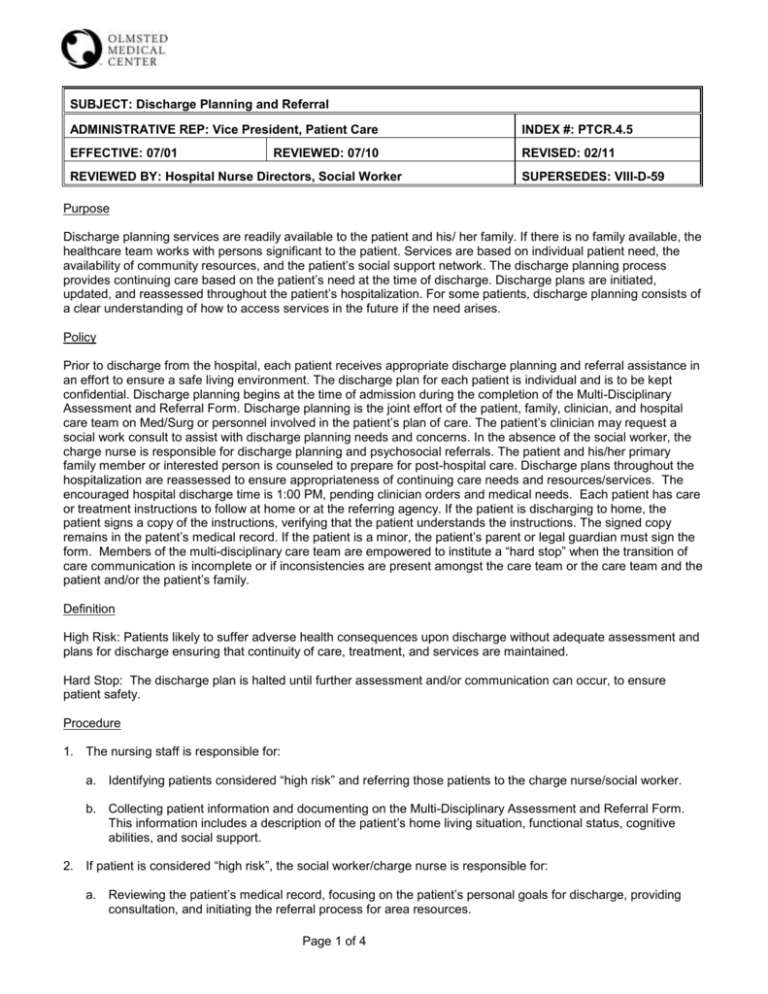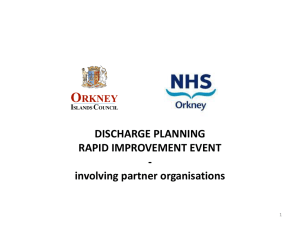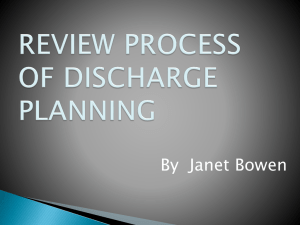Discharge Planning and Referral - Minnesota Hospital Association
advertisement

SUBJECT: Discharge Planning and Referral ADMINISTRATIVE REP: Vice President, Patient Care INDEX #: PTCR.4.5 EFFECTIVE: 07/01 REVISED: 02/11 REVIEWED: 07/10 REVIEWED BY: Hospital Nurse Directors, Social Worker SUPERSEDES: VIII-D-59 Purpose Discharge planning services are readily available to the patient and his/ her family. If there is no family available, the healthcare team works with persons significant to the patient. Services are based on individual patient need, the availability of community resources, and the patient’s social support network. The discharge planning process provides continuing care based on the patient’s need at the time of discharge. Discharge plans are initiated, updated, and reassessed throughout the patient’s hospitalization. For some patients, discharge planning consists of a clear understanding of how to access services in the future if the need arises. Policy Prior to discharge from the hospital, each patient receives appropriate discharge planning and referral assistance in an effort to ensure a safe living environment. The discharge plan for each patient is individual and is to be kept confidential. Discharge planning begins at the time of admission during the completion of the Multi-Disciplinary Assessment and Referral Form. Discharge planning is the joint effort of the patient, family, clinician, and hospital care team on Med/Surg or personnel involved in the patient’s plan of care. The patient’s clinician may request a social work consult to assist with discharge planning needs and concerns. In the absence of the social worker, the charge nurse is responsible for discharge planning and psychosocial referrals. The patient and his/her primary family member or interested person is counseled to prepare for post-hospital care. Discharge plans throughout the hospitalization are reassessed to ensure appropriateness of continuing care needs and resources/services. The encouraged hospital discharge time is 1:00 PM, pending clinician orders and medical needs. Each patient has care or treatment instructions to follow at home or at the referring agency. If the patient is discharging to home, the patient signs a copy of the instructions, verifying that the patient understands the instructions. The signed copy remains in the patent’s medical record. If the patient is a minor, the patient’s parent or legal guardian must sign the form. Members of the multi-disciplinary care team are empowered to institute a “hard stop” when the transition of care communication is incomplete or if inconsistencies are present amongst the care team or the care team and the patient and/or the patient’s family. Definition High Risk: Patients likely to suffer adverse health consequences upon discharge without adequate assessment and plans for discharge ensuring that continuity of care, treatment, and services are maintained. Hard Stop: The discharge plan is halted until further assessment and/or communication can occur, to ensure patient safety. Procedure 1. The nursing staff is responsible for: a. Identifying patients considered “high risk” and referring those patients to the charge nurse/social worker. b. Collecting patient information and documenting on the Multi-Disciplinary Assessment and Referral Form. This information includes a description of the patient’s home living situation, functional status, cognitive abilities, and social support. 2. If patient is considered “high risk”, the social worker/charge nurse is responsible for: a. Reviewing the patient’s medical record, focusing on the patient’s personal goals for discharge, providing consultation, and initiating the referral process for area resources. Page 1 of 4 Olmsted Medical Center Policy Index # PTCR.4.5 Discharge Planning and Referral b. Providing written and/or verbal education, in a timely manner, to the patient, family member, clinician, and hospital personnel directly involved with the patient’s care about the resources available in the community. This assists the patient and family member with adapting to the plan of care and tentative discharge date. This process begins upon admission and continues throughout the hospitalization. c. Providing each patient for whom post-hospital care services are indicated and appropriate, with a hospice, home health care, or nursing home list that indicates participation in the Medicare program and that serves the geographical area requested by the patient. Documenting in the patient’s chart that a list of agencies was presented to the patient or an individual acting on the patient’s behalf. The hospital does not specify or otherwise limit the qualified providers available on the list given to the patient. d. Informing the patient or the patient's representative of their freedom to choose any participating Medicare provider. When possible, Olmsted Medical Center (OMC) staff respects preferences expressed by patient and family. If patient is paying privately for services, the agency does not need to be Medicare-certified. e. Arranging services to meet the patient’s needs, after an assessment for the following needs has been completed: physical, emotional, symptom management (i.e. pain), homemaking, transportation, social, and others. Information from pre-hospitalization caregivers (i.e. nursing home) must also be incorporated into the discharge planning process. Patient rights for confidentiality, refusal, or preference for a particular agency are considered. f. Documenting updates to the discharge plan in the progress notes of the patient’s medical record, and/or on the Discharge Planning and Continuum of Care Assessment located in the progress notes section of the patient’s medical record. g. Transferring patient information to a post-discharge facility via phone, fax, US Postal Service, or patient’s inperson delivery upon his/her admission. h. Communicating the referral and discharge plan, including the transportation arrangements, to the patient and family member, clinician, nurses, and other personnel involved with the patient’s plan of care. Communication takes place primarily through morning rounds, progress notes, the kardex, patient visits, and the care board in the patient rooms. i. Completing the Agency or Non-Agency Multi-Disciplinary Discharge Summary form in a manner the patient and representative referral agency can understand. If the patient is being transferred to another healthcare facility or receiving services from other agencies responsible for continuation of care, the form, along with the patient’s admission history and physical and any physical therapy evaluations, are sent with the patient on the date of discharge. A copy of this information, including a dictated discharge summary, may be sent to that agency post discharge. j. Educating patient, family, and/or interested party on post-hospitalization care options. k. Documenting all referrals for high risk discharges on the Patient Med/Surg Referral Log filed in the social worker’s office. l. Calling Olmsted County Social Services to perform the pre-admission screening if discharge plan includes a transfer to a skilled nursing facility and the expected length of stay is more than 30 days. m. Calling the nursing home the day of transfer to provide the nursing staff at the nursing home with a report of the patient’s current status. The call should be made after faxing discharge orders to nursing home and before the patient has been physically discharged from the hospital. This is necessary information for continued care and prevention of patient readmission. n. Documenting and discussing risks associated with plan with patient/family if patient/family chooses an “unsafe discharge”. Ensure patient understands the risk(s) and chooses the unsafe plan for discharge. Consider making a report to the Common Entry Point (CEP) to report adult protection or suspected child maltreatment concerns for further in-home investigation. Page 2 of 4 Olmsted Medical Center Policy Index # PTCR.4.5 Discharge Planning and Referral NOTE: Reassessment of the patient’s condition needs to occur up to the time of the patient’s actual discharge from the hospital to assure an appropriate discharge plan. 3. Homeless Patients a. Evaluate and engage patient with available community resources including the Salvation Army (507.288.3663) and the Homeless Service Team (507.272.5715). b. If patient is accepting of the service, obtain clean and appropriate clothing for the patient from the Med/Surg storage room. c. Ensure that the agreed upon discharge plan is a “safe discharge” for the patient. Patient must be of “sound mind” (alert and oriented to person, place, and time) to make the decision to return to the homeless environment. 4. Post-Discharge Follow-Up Care a. BirthCenter Newborn appointments are scheduled for 48 hours after discharge or as directed by the pediatrician or care provider. Maternal follow-up appointments are arranged through the obstetrician or care provider. b. Outpatient Services After patient discharge, a registered nurse is responsible for completing a telephone follow-up assessment. This follow-up assessment also provides the patient with time to ask questions or express concerns about their postoperative condition. The registered nurse is able to provide further education and/or referral for follow-up care if needed. Prior to surgery, the patient is provided with a phone number to call if questions or concerns arise prior to or after the follow-up assessment phone call. The completed questionnaire is sent to Health Information Management and becomes a part of the patient’s medical record. c. Medical/Surgical Unit If the discharged patient is “high risk”, the social worker may complete a telephone follow-up assessment after patient discharge. During the follow-up assessment, the patient may also be provided with the social worker’s phone number in case questions or concerns arise after the follow-up assessment phone call. Information from the follow-up telephone assessment is documented in a clinical message in IC-Chart. d. Emergency Room A registered nurse is responsible for completing a follow-up telephone assessment after patient discharge from the Emergency Room. These follow-up assessments are done on a case-by-case basis, based on referrals made by the clinician or charge nurse. The patient is given an opportunity to ask questions and/or express concerns regarding their most recent outpatient hospital visit. The registered nurse can provide the patient with a contact phone number in the event that the patient has future questions and/or concerns. The registered nurse documents the result of the follow-up phone call in the patient’s medical record. Date Approved By Title Vice President Similar Policy(ies) None Related Document(s) Form – Agency Multi-Disciplinary Hospital Discharge Plan Form – Non-Agency Multi-Disciplinary Hospital Discharge Plan Page 3 of 4 Olmsted Medical Center Policy Index # PTCR.4.5 Discharge Planning and Referral Instruction Sheet – Discharge Planning Form – Follow-Up Phone Call Questionnaire Information Sheet – High Risk for Discharging Categories Screening Procedure Form – Discharge Planning and Continuum of Care Assessment Form – BirthCenter Discharge Planning & Continuum of Care Assessment Page 4 of 4






